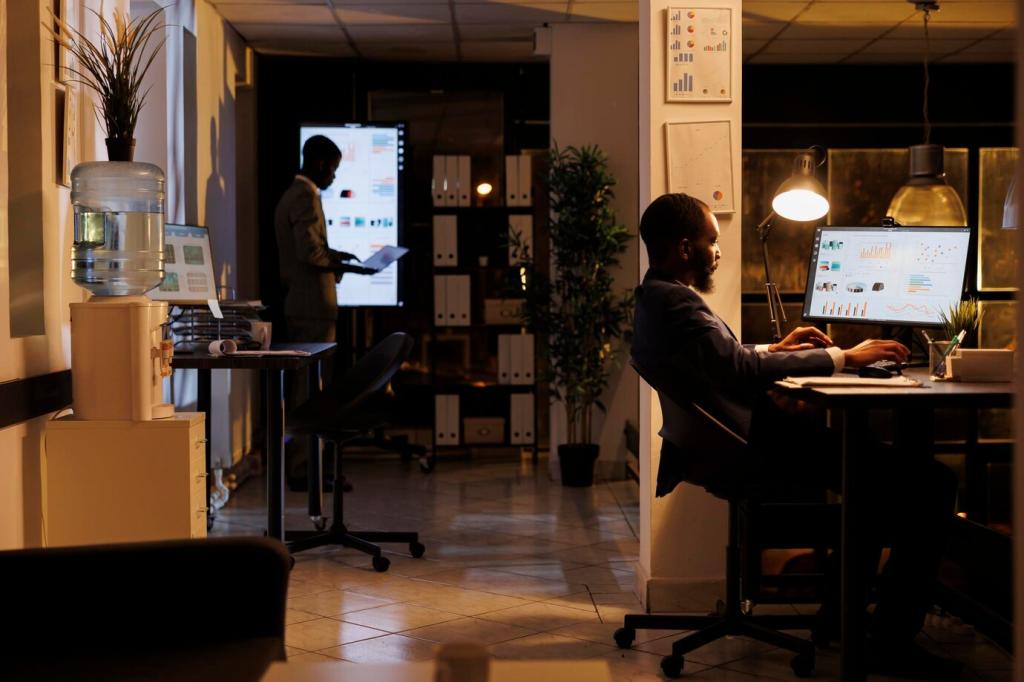The History and Transformation of Home Office Design
The evolution of home office design is a fascinating journey that reflects the changing nature of work, technology, and lifestyle over centuries. From makeshift writing desks in quiet corners to sophisticated, ergonomically engineered spaces, home offices have adapted to cultural shifts, technological advancements, and new ideas around work-life balance. This page explores the transformation of the home office, examining its historical roots, early influences, rise during the digital era, and the innovative trends redefining its purpose today and into the future.
Origins of the Home Office
Domestic Workspaces in Ancient Times
In ancient civilizations, such as Mesopotamia, Egypt, and Rome, workspaces within the home were a necessity for traders, artisans, and scholars. These were often simple nooks or tables dedicated to tasks like writing or bookkeeping. Privacy and comfort were secondary to practicality, as family life and work life merged seamlessly. The concept of separating work from home was virtually nonexistent, and the home was more a center of productivity than a private retreat. This integration laid the foundation for the work-home relationship that would evolve over centuries.
Influence of the Study in the Middle Ages
During the Middle Ages, the home study emerged as a small but significant space, primarily reserved for clergy members, scholars, or wealthy households. Books were valuable possessions, and a designated area to store and read them signified status and intellect. The study was often a private, quiet room, reflecting an early recognition of the need for dedicated, distraction-free environments to facilitate mental work. This formalization of “work” rooms began to shift home layouts in upper-class residences.
The Merchant’s Office at Home
With the growth of commerce in the Renaissance and early modern periods, merchants and traders often maintained home-based offices where they managed correspondence, inventories, and financial ledgers. These offices, while utilitarian, became a central part of both the household economy and social status. Furniture was often robust, heavy, and functional, and the space occasionally doubled as a meeting area for business associates—marking one of the first direct acknowledgments of work’s place in the physical layout of the home.
The Home Office in the Victorian Era
The Gentleman’s Study
A staple of many Victorian homes was the gentleman’s study—a richly furnished room symbolizing intellect, authority, and privacy. These studies were often adorned with ornate woodwork, plush furnishings, and extensive libraries. They represented a sanctuary for correspondence, literary pursuits, and business matters. In many ways, the gentleman’s study set the template for later home office design, emphasizing comfort, distinction, and a clear demarcation of work within the household.
Women’s Writing Desks and Parlors
While men often claimed entire studies, women’s workspaces in the Victorian home were more modest, usually in the form of small writing desks or designated corners within parlors. Despite societal limitations, these spaces allowed women to manage correspondence, household records, or creative writing. The emergence of these dedicated female workspaces was a subtle yet important development, reflecting changing attitudes toward women’s roles in society and the evolving notion of personal space for work.
The Birth of Home-Based Professionalism
By the late Victorian era, the proliferation of professions such as law, medicine, and academia required dedicated spaces for work at home. Small offices or consulting rooms became common in doctors’ houses, and professors might maintain personal libraries. This period solidified the home office’s place as both a luxury and a necessity for the rising educated classes, fostering a tradition of home-based professionalism that continues today.
Early 20th Century Adaptations
The arrival of the typewriter and telephone in home offices revolutionized the way work was conducted. These technologies increased the efficiency and scope of home-based work, necessitating more structured and designated work areas. Furniture became more streamlined to accommodate equipment, and rooms were often organized to optimize productivity rather than just display status. The home office began to morph from a symbol of affluence to a practical workspace for a growing group of professionals.
Throughout the early to mid-1900s, having a home office became increasingly associated with middle-class aspiration and achievement. Architectural plans for suburban homes started to include “dens” or “studies” as standard features, signifying both a commitment to professional life and an awareness of the value of personal space for concentrated work. The home office’s function broadened, serving not just business needs but also hobbies, education, and letter writing.
Even before the digital age, some professionals—such as writers, consultants, and small business owners—adopted the home office as their central base of operations. These early remote work pioneers set a precedent for flexible, home-based employment, often customizing their spaces to fit unique occupational demands. The growth of mail-order businesses and freelance work during this time hinted at future transformations in the home office landscape.

The Rise of Home Computing
Computers Enter the Home
The arrival of home computers in the 1980s and 1990s was a watershed moment for the home office. Suddenly, workspaces needed to accommodate desktops, monitors, and later, modems and printers. Many households reconfigured spare rooms, basements, or corners of living spaces to house computer workstations, often improvising with furniture and storage. The technological requirements of home offices prompted a reevaluation of spatial organization and utility in domestic design.
The Evolution of Office Furniture
With computers becoming central to home workspaces, the demand for specialized office furniture soared. Ergonomic chairs, computer desks with keyboard trays, and cable management solutions soon proliferated. Manufacturers responded with a wide range of products tailored to fit into both dedicated rooms and multifunctional home environments. This period also saw the rise of modular and space-saving designs, enabling people to create efficient offices even in limited spaces.
Early Days of Telecommuting
As internet connectivity improved, so did the feasibility of telecommuting. Early adopters—especially those in tech, creative, and consulting sectors—began to spend significant amounts of time working from home. This necessitated more robust infrastructure, from dedicated phone lines to high-speed modems. The home office was no longer an occasional-use space; for many, it became the primary workplace, setting the stage for later remote work revolutions.
The Digital Revolution and Remote Work
The Always-Connected Workspace
With the advent of high-speed internet and wireless networks, the home office became an “always-on” environment. Workers could communicate instantly, share large files, and collaborate remotely with teams across the globe. This connectivity changed the way home offices were designed, placing a premium on reliable technology infrastructure, soundproofing, and even backup power solutions to ensure consistent productivity.
The Home Office as a Multifunctional Hub
As digital tools allowed greater workplace flexibility, the distinction between work and leisure spaces within the home became blurred. Many home offices evolved to serve multiple functions: a spot for video conferencing during the day, a study room in the afternoon, and even a gaming setup in the evening. Interior design trends shifted toward flexible, modular furniture and aesthetic choices that bridged professional and personal needs.
Influence of Collaboration Technologies
The rise of collaboration platforms—such as Slack, Zoom, and shared document systems—reshaped the home office into a node in a global digital network. This influenced both the physical organization of the workspace and workers’ routines, demanding attention to lighting, backgrounds, and acoustics for video calls. Design shifted to accommodate not just solitude for focused work, but also the need for polished, presentable environments for virtual meetings.
The Impact of the Pandemic Era
Accelerating the Remote Work Movement
Lockdowns and social distancing forced a rapid transition to remote work across many industries. This accelerated ongoing trends and made home offices an essential feature rather than a luxury. People improvised workspaces in bedrooms, kitchens, and even closets, highlighting both the challenges and creative potential of remote work. Companies and individuals alike began to recognize the critical role of home office design in productivity and mental health.
Wellness and Ergonomics Take Center Stage
The prolonged nature of remote work brought physical and mental health to the forefront. Awareness grew around ergonomics, daylight exposure, air quality, and movement, prompting redesigns that prioritized supportive chairs, standing desks, and biophilic design elements. The focus shifted from mere functionality to creating spaces that support long-term health and motivation, recognizing that the home office is as much a living space as a professional one.
Rethinking Flexibility and Privacy
The need to balance professional and personal life in tight quarters led to inventive solutions for flexibility and privacy. People installed acoustic panels, divided open spaces with screens, and adopted convertible furniture. As households juggled multiple remote workers and learners, designing for quiet, adaptable work zones became crucial. This shift also spurred new products and services tailored to meet the evolving demands of remote work environments.

Previous
Next
Contemporary Design Trends
Contemporary home offices are increasingly characterized by clean lines, uncluttered spaces, and personalized touches. Minimalist design helps reduce distractions and stress, while personalization—through color choices, art, or memorabilia—enhances comfort and creativity. Designers encourage individuals to curate their workspace to reflect not only professional demands but also personal tastes and routines.
The Future of Home Office Design
As more companies embrace hybrid work models that combine office and remote work, home office design will adapt to support both temporary and permanent work needs. This may involve flexible layouts, convertible furniture, and more widespread use of shared or communal workspaces within residential buildings. Maximizing the versatility of small spaces will be an ongoing challenge and opportunity for designers.
Previous
Next
